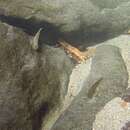Life Cycle
provided by Fishbase
Excavates nests below the gravel bottom. Male provides most of the parental care. Newly hatched larve emerge from nests upon hatching and enter the river plankton. They migrate to the sea where they stay for 50-150 days before re-entering the rivers as postlarvae.
Migration
provided by Fishbase
Amphidromous. Refers to fishes that regularly migrate between freshwater and the sea (in both directions), but not for the purpose of breeding, as in anadromous and catadromous species. Sub-division of diadromous. Migrations should be cyclical and predictable and cover more than 100 km.Characteristic elements in amphidromy are: reproduction in fresh water, passage to sea by newly hatched larvae, a period of feeding and growing at sea usually a few months long, return to fresh water of well-grown juveniles, a further period of feeding and growing in fresh water, followed by reproduction there (Ref. 82692).
Morphology
provided by Fishbase
Dorsal spines (total): 7; Dorsal soft rays (total): 10; Analspines: 1; Analsoft rays: 9 - 10
Biology
provided by Fishbase
Found abundant in rivers of coastal volcanic topography (Ref. 12113). Adults spawn in rivers with coarse substrate, building nests under stones (Ref. 33036).
Importance
provided by Fishbase
fisheries: minor commercial

